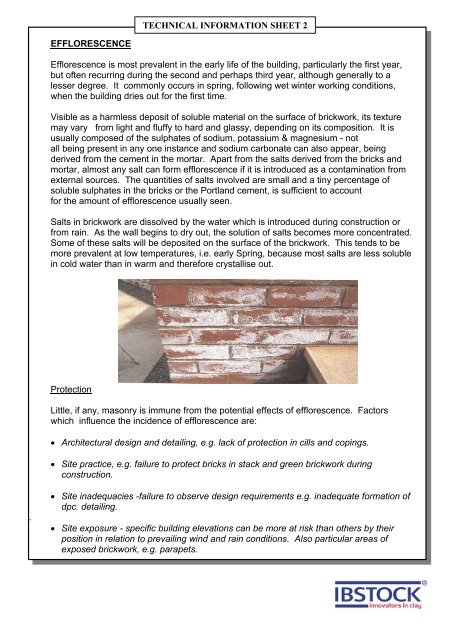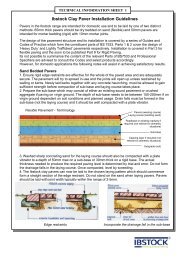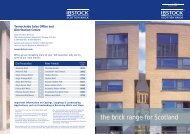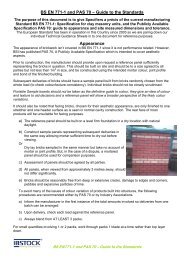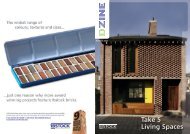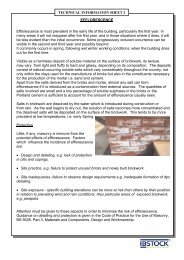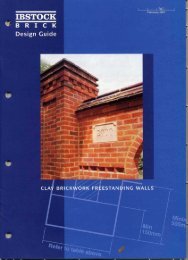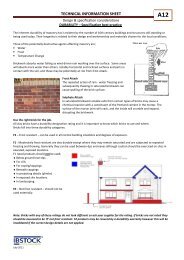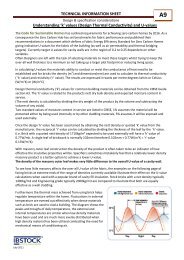EFFLORESCENCE Efflorescence is most prevalent in the ... - Ibstock
EFFLORESCENCE Efflorescence is most prevalent in the ... - Ibstock
EFFLORESCENCE Efflorescence is most prevalent in the ... - Ibstock
You also want an ePaper? Increase the reach of your titles
YUMPU automatically turns print PDFs into web optimized ePapers that Google loves.
TECHNICAL INFORMATION SHEET 2<br />
<strong>EFFLORESCENCE</strong><br />
<strong>Efflorescence</strong> <strong>is</strong> <strong>most</strong> <strong>prevalent</strong> <strong>in</strong> <strong>the</strong> early life of <strong>the</strong> build<strong>in</strong>g, particularly <strong>the</strong> first year,<br />
but often recurr<strong>in</strong>g dur<strong>in</strong>g <strong>the</strong> second and perhaps third year, although generally to a<br />
lesser degree. It commonly occurs <strong>in</strong> spr<strong>in</strong>g, follow<strong>in</strong>g wet w<strong>in</strong>ter work<strong>in</strong>g conditions,<br />
when <strong>the</strong> build<strong>in</strong>g dries out for <strong>the</strong> first time.<br />
V<strong>is</strong>ible as a harmless deposit of soluble material on <strong>the</strong> surface of brickwork, its texture<br />
may vary from light and fluffy to hard and glassy, depend<strong>in</strong>g on its composition. It <strong>is</strong><br />
usually composed of <strong>the</strong> sulphates of sodium, potassium & magnesium - not<br />
all be<strong>in</strong>g present <strong>in</strong> any one <strong>in</strong>stance and sodium carbonate can also appear, be<strong>in</strong>g<br />
derived from <strong>the</strong> cement <strong>in</strong> <strong>the</strong> mortar. Apart from <strong>the</strong> salts derived from <strong>the</strong> bricks and<br />
mortar, al<strong>most</strong> any salt can form efflorescence if it <strong>is</strong> <strong>in</strong>troduced as a contam<strong>in</strong>ation from<br />
external sources. The quantities of salts <strong>in</strong>volved are small and a t<strong>in</strong>y percentage of<br />
soluble sulphates <strong>in</strong> <strong>the</strong> bricks or <strong>the</strong> Portland cement, <strong>is</strong> sufficient to account<br />
for <strong>the</strong> amount of efflorescence usually seen.<br />
Salts <strong>in</strong> brickwork are d<strong>is</strong>solved by <strong>the</strong> water which <strong>is</strong> <strong>in</strong>troduced dur<strong>in</strong>g construction or<br />
from ra<strong>in</strong>. As <strong>the</strong> wall beg<strong>in</strong>s to dry out, <strong>the</strong> solution of salts becomes more concentrated.<br />
Some of <strong>the</strong>se salts will be deposited on <strong>the</strong> surface of <strong>the</strong> brickwork. Th<strong>is</strong> tends to be<br />
more <strong>prevalent</strong> at low temperatures, i.e. early Spr<strong>in</strong>g, because <strong>most</strong> salts are less soluble<br />
<strong>in</strong> cold water than <strong>in</strong> warm and <strong>the</strong>refore crystall<strong>is</strong>e out.<br />
Protection<br />
Little, if any, masonry <strong>is</strong> immune from <strong>the</strong> potential effects of efflorescence. Factors<br />
which <strong>in</strong>fluence <strong>the</strong> <strong>in</strong>cidence of efflorescence are:<br />
• Architectural design and detail<strong>in</strong>g, e.g. lack of protection <strong>in</strong> cills and cop<strong>in</strong>gs.<br />
• Site practice, e.g. failure to protect bricks <strong>in</strong> stack and green brickwork dur<strong>in</strong>g<br />
construction.<br />
.<br />
• Site <strong>in</strong>adequacies -failure to observe design requirements e.g. <strong>in</strong>adequate formation of<br />
dpc. detail<strong>in</strong>g.<br />
• Site exposure - specific build<strong>in</strong>g elevations can be more at r<strong>is</strong>k than o<strong>the</strong>rs by <strong>the</strong>ir<br />
position <strong>in</strong> relation to prevail<strong>in</strong>g w<strong>in</strong>d and ra<strong>in</strong> conditions. Also particular areas of<br />
exposed brickwork, e.g. parapets.
TECHNICAL INFORMATION SHEET 2<br />
Attention must <strong>the</strong>refore be given to <strong>the</strong>se aspects <strong>in</strong> order to m<strong>in</strong>im<strong>is</strong>e <strong>the</strong> r<strong>is</strong>k of<br />
efflorescence. Guidance on detail<strong>in</strong>g and protection <strong>is</strong> given <strong>in</strong> <strong>the</strong> Code of Practice for <strong>the</strong><br />
Use of Masonry, BS 5628, Part 3, Materials and Components, Design and Workmanship.<br />
<strong>Efflorescence</strong> dur<strong>in</strong>g construction can be m<strong>in</strong>im<strong>is</strong>ed by ma<strong>in</strong>ta<strong>in</strong><strong>in</strong>g a high standard of<br />
workmanship. Items for particular consideration <strong>in</strong>clude <strong>the</strong> follow<strong>in</strong>g:<br />
Bricks should be stacked onto, a clean, firm level surface. They should be protected from<br />
ra<strong>in</strong>, mud splashes, etc. by cover<strong>in</strong>g with waterproof covers.<br />
Remove <strong>the</strong> scaffold<strong>in</strong>g boards closest to <strong>the</strong> brickwork at all <strong>in</strong>terruptions to construction.<br />
Newly erected masonry should be covered to protect cavities and stop masonry becom<strong>in</strong>g<br />
saturated. Unless <strong>in</strong>structed, <strong>the</strong> method of "dipp<strong>in</strong>g" bricks prior to lay<strong>in</strong>g should be<br />
avoided.<br />
Equally important <strong>is</strong> <strong>the</strong> <strong>in</strong>corporation of <strong>the</strong> appropriate d.p.c.'s, cop<strong>in</strong>gs and cills at <strong>the</strong><br />
design stage. No amount of good site management can alleviate efflorescence from a<br />
badly designed construction.<br />
Remedial<br />
In consider<strong>in</strong>g remedial treatments, efflorescence should preferably be allowed to<br />
wea<strong>the</strong>r away naturally. Its removal can be accelerated <strong>in</strong> more severely affected<br />
areas by dry-brush<strong>in</strong>g followed by a f<strong>in</strong>e water spray, <strong>the</strong> residue be<strong>in</strong>g collected and<br />
removed so that it does not re-enter <strong>the</strong> brickwork at a lower level.<br />
The use of a silicone treatment should be avoided s<strong>in</strong>ce th<strong>is</strong> can result <strong>in</strong> more<br />
permanent problems.<br />
The majority of efflorescence compla<strong>in</strong>ts relate to new brickwork. Recurrent efflorescence<br />
on older establ<strong>is</strong>hed brickwork can often be taken as an <strong>in</strong>dication that water <strong>is</strong> enter<strong>in</strong>g <strong>the</strong><br />
masonry as a result of failure of wea<strong>the</strong>r<strong>in</strong>g and o<strong>the</strong>r protective measures, e.g. faulty<br />
gutters.<br />
Amendment No 1 to BS 3921:1985 (effective 15 December 1995) removed reference to all<br />
efflorescence categories due to <strong>in</strong>cons<strong>is</strong>tency of results from <strong>the</strong> test method.<br />
For fur<strong>the</strong>r <strong>in</strong>formation and advice regard<strong>in</strong>g th<strong>is</strong> topic please contact <strong>Ibstock</strong> Brick Limited<br />
on 0870 903 4017.<br />
Issue 5, April 2004


